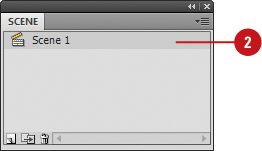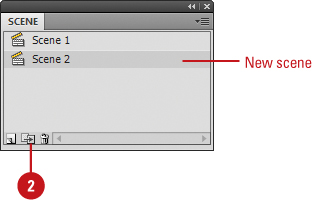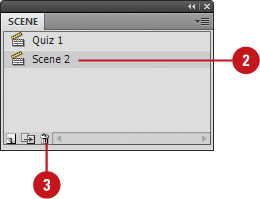If a project requires a lot of animations
with hundreds of frames, you can organize the animations into scenes to
make them easier to work with and manage. The Scene panel makes it easy
to display the number of scenes in the document, select current scenes
for editing, create new scenes, duplicate scenes, delete scenes, and
reorder them. You can also use the Edit bar to select a scene to edit.
When you select a scene, Flash displays it on the Stage. When you
publish a document as a movie, the scenes play in order unless you add
interactivity to play them differently. Be aware that scenes are treated
like self-contained movies, so transitions between scenes with
interactivity may not be seamless.
Open the Scene Panel and Select a Scene
1.Click the Window menu, point to Other Panels, and then click Scene.
Timesaver
Press Shift+F2.
|
2. Click the scene you want to display.

|
Add a Scene
1. If necessary, open the Scene panel.
|
2. Click the Add Scene button in the Scene panel.

Did You Know?
Flash names scenes in order based on the highest number. If you add Scenes 2 and 3, and then delete Scene 2, the next time you add a scene, Flash names it Scene 4.
|
Rename a Scene
1.
If necessary, open the Scene panel.
|
2. Double-click the scene you want to rename.

|
3. Type a new name.
|
4. Press Return (Mac) or Enter (Win).
|
Delete a Scene
1. If necessary, open the Scene panel.
|
2. Click the scene you want to delete.

|
3. Click the Delete Scene button in the Scene panel.
|
4. Click OK to confirm the deletion.
Timesaver
If you don’t want to display the Confirmation dialog box, press
 +click (Mac) or Ctrl+click (Win) the Delete Scene button.
+click (Mac) or Ctrl+click (Win) the Delete Scene button.
Did You Know?
You can undo the deletion of a scene. If you mistakenly delete a scene, you can undo; press
 +Z (Mac) or Ctrl+Z (Win).
+Z (Mac) or Ctrl+Z (Win).
You can reorder scenes in the Scene panel.
In the Scene panel, drag a selected scene up or down in the list.
|
After you finish creating and working with
scenes in a Flash document, you can quickly playback all the scenes in
Flash or test a scene in a browser with commands on the Control menu. To
playback all scenes in the order in which they appear in the Scenes
panel, click the Control menu, and then click Play All Scenes. To test
the active scene, click the Control menu, and then click Test Scene. To
change the settings for the SWF file created using the Test Scene
command, use the Publish Settings command on the File menu.